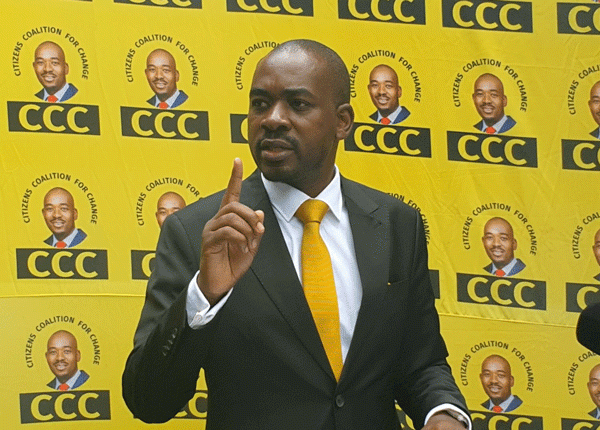
THE Nelson Chamisa-led Citizens Coalition for Change (CCC) party has just released its extensive election manifesto outlining its vision for transforming Zimbabwe if elected into power.
The 100-page manifesto covers a broad range of issues from economic reforms social services to governance.
It offers valuable insights into CCC’s priorities and policy positions.
The manifesto places heavy emphasis on reviving Zimbabwe’s economy and charting a pathway to a US$100 billion economy within a decade.
However, it is interesting to note that less than 10 African countries currently have US$100 billion economies.
It rightly identifies the economy as the country’s Achilles heel after years of mismanagement.
However, the mechanisms proposed for generating such robust growth rates consistently seem overly optimistic.
While agriculture, mining and infrastructural investment have the potential, the sheer scale and speed of the projected transformation appears unrealistic considering Zimbabwe’s current woes.
- News in depth: Fears of violent 2023 polls grow as ED fails to deliver on promises
- Chamisa party defiant after ban
- Letter to my people: Mthuli Ncube experiment has failed
- News in depth: Slain Moreblessing Ali’s family fears cover-up as children are forced into hiding
Keep Reading
A more gradual, incremental approach may be prudent. Infrastructure rehabilitation forms a key pillar of CCC’s economic plans.
The party pledges major investments in rebuilding dilapidated roads, rail, power stations, airports and dams.
This is long overdue given Zimbabwe’s huge infrastructure deficit.
However, funding such an expansive national rebuilding programme hinges on the party’s ability to secure substantial international support and investment post-election.
The debt resolution strategy outlined will be critical.
On governance, CCC promises extensive reforms, including a new Constitution, reduced Cabinet, strengthened Parliament, decentralisation and anti-corruption laws.
While a reduced Cabinet will be a step in the right direction, it might be a difficult ask for a movement that previously had a bloated presidium.
While vital, implementing such sweeping changes even with political will takes time.
CCC may need to sequence reforms, starting with more achievable steps like trimming Cabinet and tasking Parliament with oversight before tackling bigger structural changes.
CCC’s social policy commitments around healthcare, education, housing and social security are morally compelling, but also expensive.
The manifesto does not outline in adequate detail how these will be funded sustainably.
Zimbabwe’s dire economic situation means finances are extremely constrained.
A more incremental expansion aligned with realistic revenue forecasts would be prudent.
One other notable aspect of the manifesto is its heavy emphasis on restoring Zimbabwe to a Christian, God-fearing nation.
While freedom of religion is vital, the centring of Christianity raises concerns about pluralism and diversity.
The manifesto states that: “We will restore Zimbabwe to God in honour, values, faith, worship and praise,” and promises to “rededicate Zimbabwe to God”.
Despite being a Christian, I find the constant reference to Biblical scriptures in the manifesto alienating other religions.
Such rhetoric seems to privilege Christianity above other beliefs.
There is little mention of protecting minority faiths or recognising Zimbabwe’s religious diversity.
This risks alienating non-Christians and undermining religious tolerance.
A truly democratic vision would be more inclusive of all faiths and avoid language that elevates one religion over others.
The manifesto’s Christian-centric tone could worry secular citizens and religious minorities about their place in CCC’s future Zimbabwe.
While expansive in scope, the dense 100-page manifesto does not seem optimally simplified and condensed for easy digestion by the average voter.
The prose is lengthy, detailed and at times overly technical for a document aimed at a mass electorate.
There is opportunity to present core proposals and commitments in more straightforward, easy-to-grasp language and formatting.
For instance, the economic plan could be distilled into three to five key actionable bullet points.
The decentralisation reforms could be summarised in a simple infographic. Pull quotes, charts and graphics could make the manifesto more visually engaging.
A abbreviated citizen-focused version highlighting major takeaways on what CCC will deliver for voters if elected could resonate more broadly with the masses.
Accessibility and clarity are crucial for manifestos to effectively reach and inspire citizens.
CCC may need to find ways to simplify its vision further to maximise impact among the Zimbabwean voters.
In summary, CCC’s manifesto sets out an ambitious reform agenda and provides a broad direction for Zimbabwe’s future.
However, the sheer scale and speed of the planned transformation seems unrealistic considering current challenges.
Careful prioritisation, sequencing of reforms and consensus-building will be essential if CCC wins power.
While aspirational, CCC must balance its bold vision with pragmatism in execution if the dreams outlined are to become reality.
Kudzayi Tarisayi is a BEd degree programme senior lecturer in the Faculty of Education at the University. Stellenbosch. He writes here in his personal capacity.











